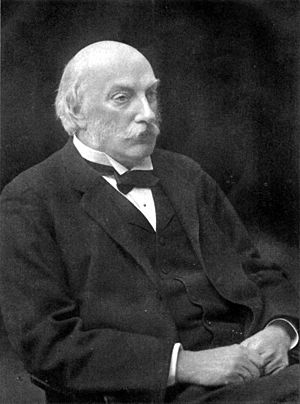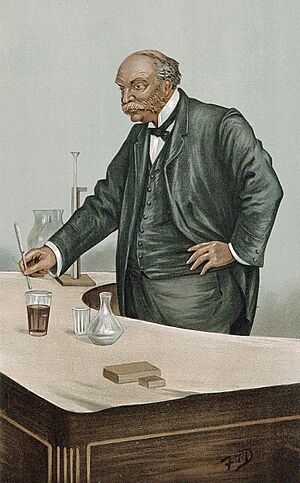John William Strutt, 3rd Baron Rayleigh facts for kids
Quick facts for kids
The Lord Rayleigh
|
|
|---|---|

Rayleigh in 1904
|
|
| Born | 12 November 1842 Langford Grove, Maldon, Essex, England
|
| Died | 30 June 1919 (aged 76) Terling Place, Witham, Essex, England
|
| Nationality | British |
| Alma mater | Trinity College, Cambridge Eton College |
| Known for |
List
Discovery of argon
Plateau–Rayleigh instability Rayleigh waves Rayleigh scattering Rayleigh criterion Rayleigh distance Rayleigh–Bénard convection Rayleigh–Brace experiments Rayleigh–Faber–Krahn inequality Rayleigh's criterion Rayleigh's criterion (thermoacoustics) Rayleigh distribution Rayleigh interferometer Rayleigh's method of dimensional analysis Rayleigh–Ritz method Rayleigh quotient Rayleigh–Lorentz pendulum Rayleigh–Gans approximation Rayleigh dissipation function Rayleigh fading Rayleigh flow Rayleigh's formulas Rayleigh fractionation Rayleigh law Rayleigh number Rayleigh problem Rayleigh–Carson reciprocity Rayleigh–Plesset equation Rayleigh–Schrödinger perturbation theory Rayleigh Still Rayleigh–Taylor instability Rayleigh–Jeans catastrophe Rayleigh–Jeans law Rayleigh's equation Janzen–Rayleigh expansion Rayleigh limit Rayleigh test Rayleigh theorem for eigenvalues Rayleigh's energy theorem Rayleigh's theorem Acoustic streaming Anti-reflective coating Bending theory End correction Drag equation Dynamic soaring Duplex theory Optical theorem Photonic crystal Principle of similitude |
| Spouse(s) |
Evelyn Balfour
(m. 1871) |
| Children | 3 sons |
| Awards |
|
| Scientific career | |
| Fields | Physics, optics, acoustics |
| Institutions | Trinity College, Cambridge |
| Academic advisors | |
| Notable students | |
| Signature | |
 |
|
John William Strutt, 3rd Baron Rayleigh, born on November 12, 1842, was a brilliant British scientist. He was a mathematician and physicist who made many important discoveries. He spent his whole career at the University of Cambridge.
In 1904, he won the Nobel Prize in Physics. This was for his work on how dense different gases are. He also discovered the gas called argon during these studies. He led the Royal Society from 1905 to 1908. He was also the head of the University of Cambridge from 1908 to 1919.
Rayleigh was the first to explain why the sky is blue. He showed how light scatters off tiny particles in the air. This effect is now called "Rayleigh scattering". He also studied "Rayleigh waves," which are special waves that travel on the surface of solids. He made big contributions to how liquids and gases move, called fluid dynamics. He developed ideas like the Rayleigh number and the Rayleigh–Taylor instability. He also helped explain how airplanes get lift to fly. In the study of light (optics), he came up with a way to measure how clearly we can see small details. His work on the Rayleigh–Jeans law was important for the start of quantum mechanics. His book The Theory of Sound (1877) is still used by scientists today.
Contents
About Lord Rayleigh's Life
John William Strutt was born on November 12, 1842, in Langford Grove, Maldon, Essex. When he was young, he was often sick and not very strong. He went to Eton College and Harrow School for short times. In 1861, he went to the University of Cambridge to study mathematics.
He earned his first degree in 1865 and a master's degree in 1868. He became a fellow at Trinity College. In 1871, he married Evelyn Balfour and they had three sons. In 1873, his father passed away. John then inherited the title of Baron Rayleigh, becoming the 3rd Lord Rayleigh.
His Work at Cambridge and Beyond
From 1879 to 1884, Lord Rayleigh was the second Cavendish Professor of Physics at the University of Cambridge. He followed the famous scientist James Clerk Maxwell. In 1883, he wrote about how seabirds glide without flapping their wings, a process called dynamic soaring. From 1887 to 1905, he was a professor at the Royal Institution.
Around 1900, Rayleigh developed a theory about how humans figure out where sounds come from. This is called the duplex theory. It explains that our brains use two main clues: the difference in when a sound reaches each ear and the difference in how loud it is in each ear.
In 1904, he received the Nobel Prize for Physics. This was for his careful studies of gas densities. These studies led to his discovery of the gas argon.
During World War I, he was in charge of the government's Advisory Committee for Aeronautics. This committee helped with aviation research.
In 1919, Rayleigh became the president of the Society for Psychical Research. This group studied unexplained mental abilities. He believed that science should be simple and based on clear theories. He supported the idea of principle of similitude, which means using models to understand bigger things.
He was chosen as a member of the Royal Society in 1873. He served as its president from 1905 to 1908. He also sometimes took part in discussions in the House of Lords, which is part of the British Parliament. He only spoke up if politics tried to interfere with science.
Many of his writings on lubrication (how things slide smoothly) are still important today. He is seen as one of the key figures in the field of tribology, which is the study of friction, wear, and lubrication.
Lord Rayleigh passed away on June 30, 1919, at his home in Witham, Essex. His son, Robert John Strutt, who was also a physicist, became the 4th Lord Rayleigh. Lord Rayleigh was buried in the churchyard of All Saints' Church in Terling. There is also a memorial to him in Westminster Abbey.
His Views on Spiritual Matters
Rayleigh was a member of the Anglican Church. While he didn't write much about science and religion together, he was personally interested in spiritual topics.
He was also interested in parapsychology, which looks at psychic phenomena. He was an early member and president of the Society for Psychical Research in 1919. He wasn't fully convinced by spiritualism, but he was open to the idea of supernatural events. He gave a speech as president shortly before he died, but he didn't come to any firm conclusions.
Awards and Recognition
Lord Rayleigh received many honors for his scientific work. Some of the most important ones include:
- Smith's Prize (1864)
- Royal Medal (1882)
- Matteucci Medal (1894)
- Copley Medal (1899)
- Nobel Prize in Physics (1904)
- Elliott Cresson Medal (1913)
- Rumford Medal (1914)
The Rayleigh crater on the Moon and the Rayleigh crater on Mars are named after him. An asteroid, 22740 Rayleigh, was also named in his honor in 2007. The rayl, a unit used to measure how sound travels through materials, is also named after him.
In 1902, he was one of the first people to receive the Order of Merit (OM). This is a special honor given by the British monarch for outstanding service. He received it from King Edward VII.
In 1902, he also received an honorary degree from the University of Oslo in Norway. This was part of a celebration for the famous mathematician Niels Henrik Abel.
Sir William Ramsay, who worked with Rayleigh to discover argon, once called him "the greatest man alive."
See also
 In Spanish: Lord Rayleigh para niños
In Spanish: Lord Rayleigh para niños
Images for kids


